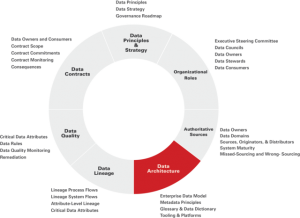The data architecture capability will supply the components and standards necessary to implement other capabilities coherently and enable them to work together. A primary responsibility of data architecture is to define and have an accepted enterprise-wide set of models, standards, glossaries and hierarchies which allow a standard description of data across business lines, products and functional areas.
An enterprise data model provides a common, well-understood classification of data. This needs to be abstract enough to gain acceptance across the financial institution, yet maintain an appropriate level of detail required to support clear ownership.
A standard business glossary is required to define business terms along with links or mappings to the various technical data dictionaries that define the production management of these items as data attributes. Together, these will ensure an underlying commonality between authoritative sources, data lineage, and data quality, and in turn data contracts.
Data architecture will also be involved in the review and assessment of tooling and platforms for use by each of the various capabilities. Fragmented, duplicative and aging systems should be evaluated in favor of simpler, enterprise-wide approaches.
In addition, the establishment of common metadata principles is required to enable interoperability of tools across the capability areas.
We recently published a guide that explores the building blocks (i.e., data governance components) of data governance, which can help drive better business decisions, enhance regulatory compliance, and improve risk management. You can download it here.


